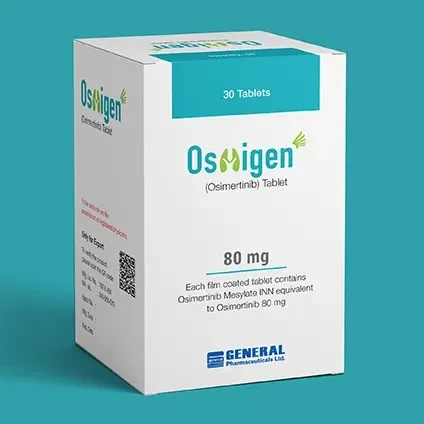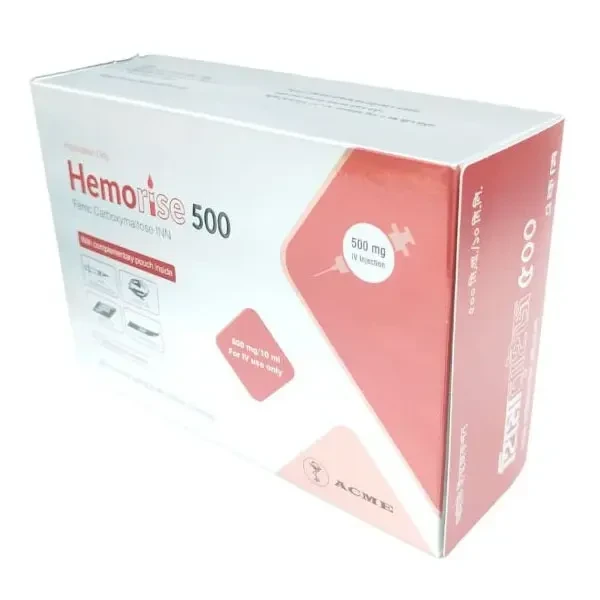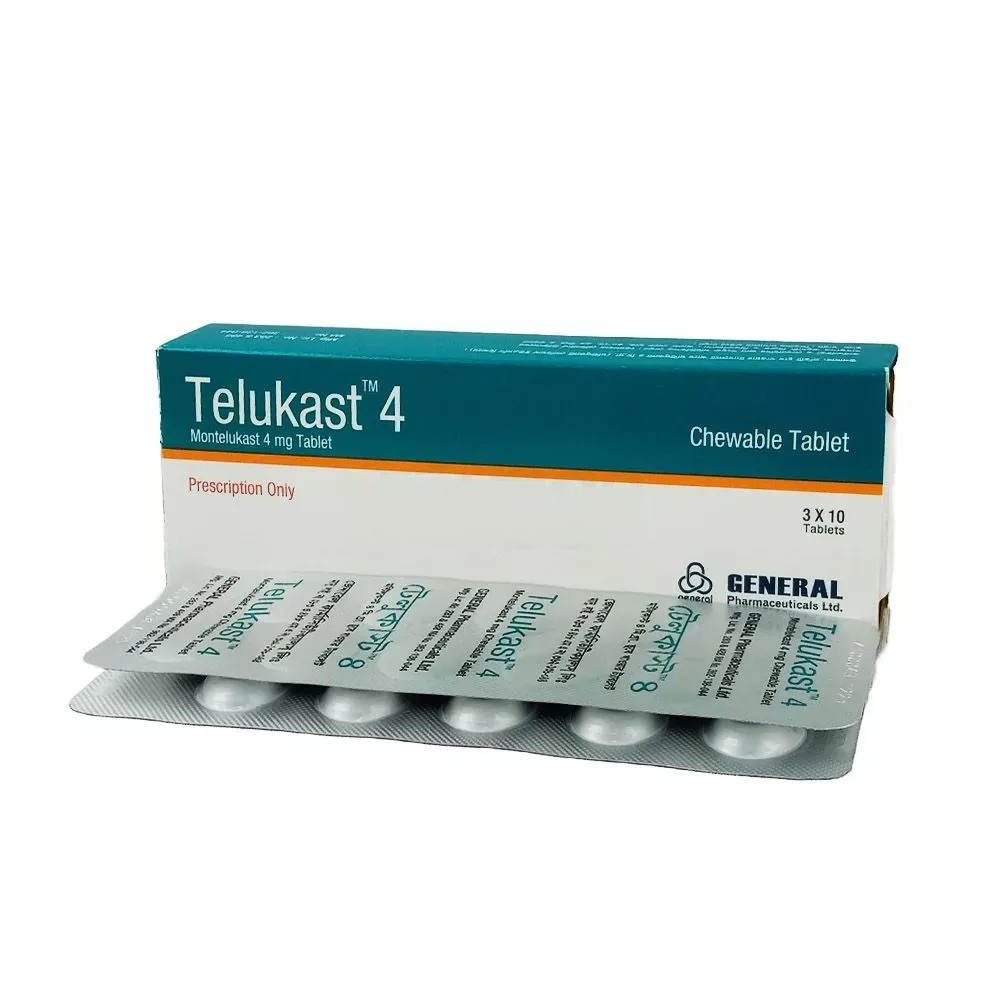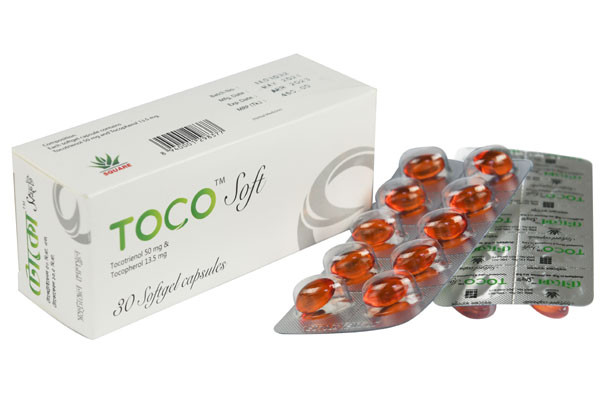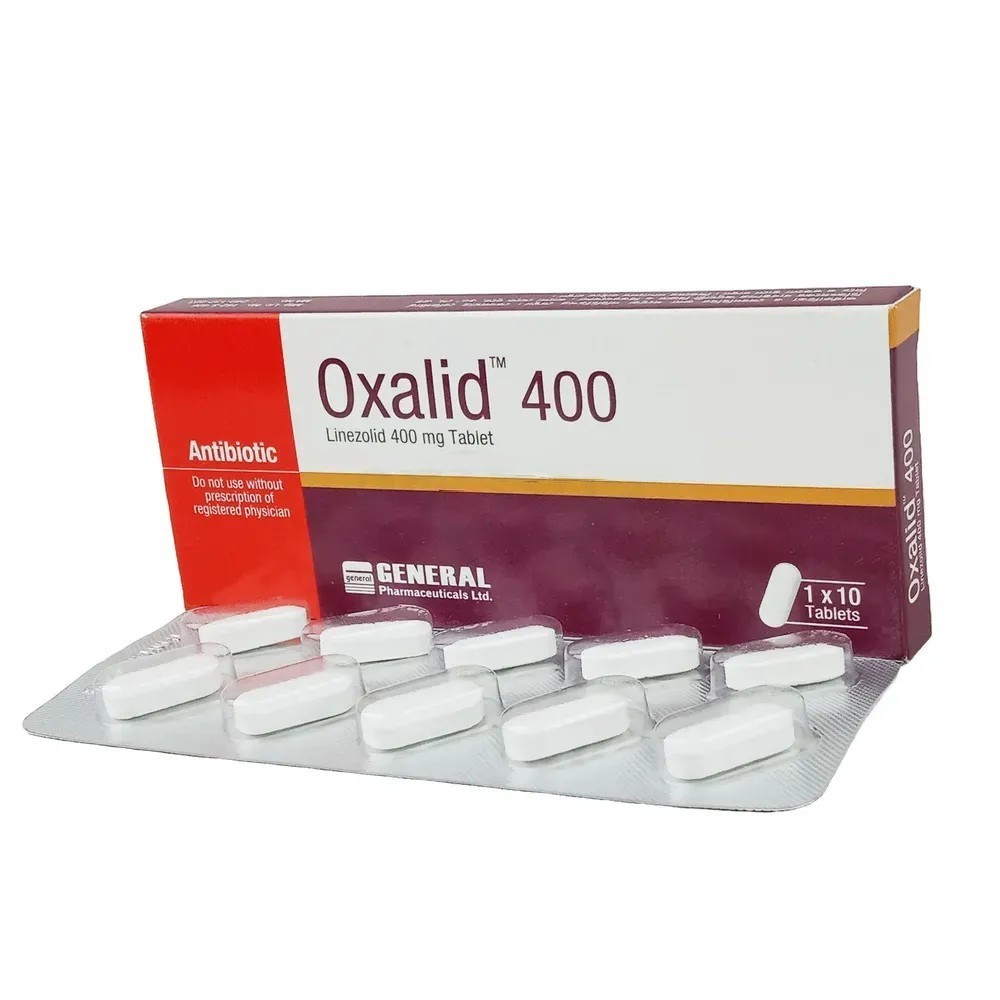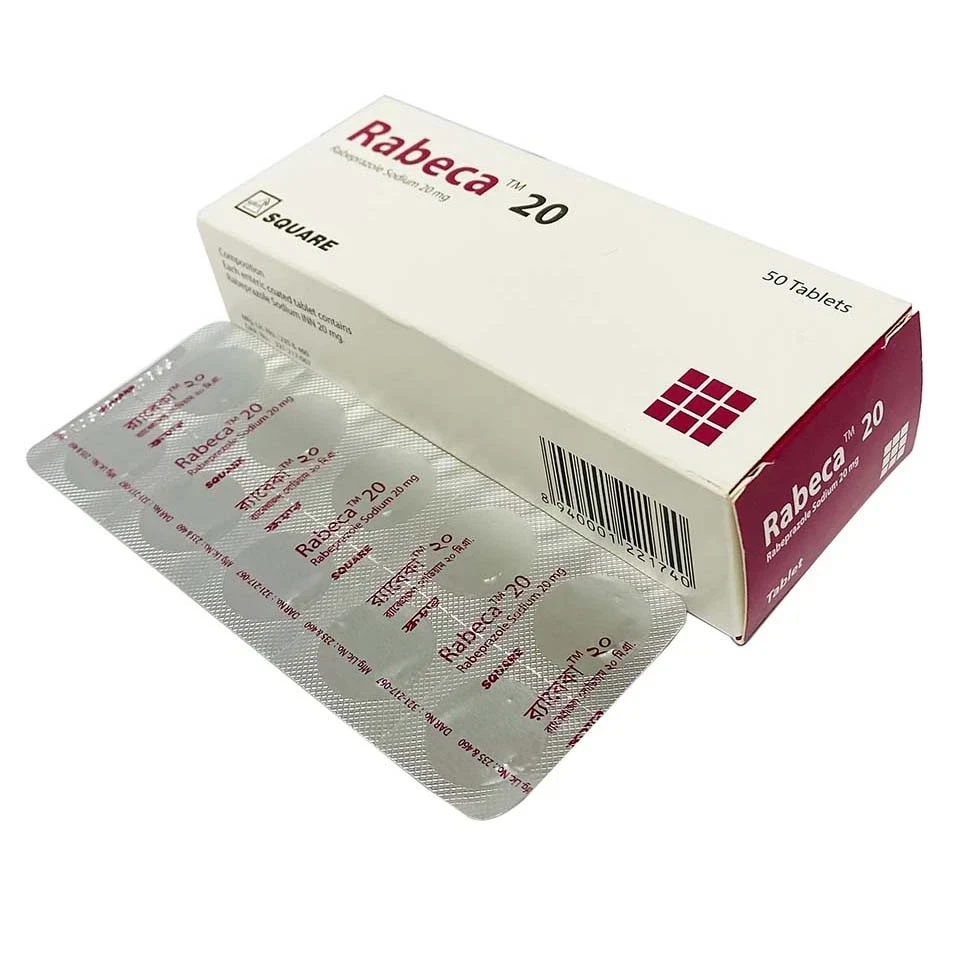

Rabeca Tablet (Enteric Coated), Rabeprazole Sodium 20 mg
Inhouse product
-
৳11.40
৳12.00 -
৳42.75
৳45.00 -
৳16.63
৳17.50 -
৳2.14
৳2.25
Reviews & Ratings
Indications
Rabeca is indicated
for the treatment of:
- Active duodenal ulcer
- Active benign gastric ulcer
- Symptomatic erosive or
ulcerative gastro-esophageal reflux disease (GERD).
- Gastro-esophageal Reflux
Disease Long-term Management (GERD Maintenance)
- Symptomatic treatment of
moderate to very severe gastro-esophageal reflux disease (symptomatic
GERD)
- Zollinger-Ellison Syndrome
- In combination with appropriate
antibacterial therapeutic regimens for the eradication of Helicobacter
pylori in patients with peptic ulcer disease.
* রেজিস্টার্ড চিকিৎসকের পরামর্শ মোতাবেক ঔষধ সেবন করুন'
Pharmacology
Rabeprazole suppresses
gastric acid secretion by inhibiting the gastric H+/K+-ATPase at the secretory surface of the
gastric parietal cell. Because this enzyme is regarded as the acid (proton)
pump within the parietal cell, Rabeprazole has been characterized as a gastric
proton-pump inhibitor.
Dosage
Active Duodenal Ulcer and Active
Benign Gastric Ulcer: The recommended oral
dose for both bioactive duodenal ulcer and active benign gastric ulcer is 20 mg
to be taken once daily in the morning. Most patients with active duodenal ulcer
heal within four weeks. However, a few patients may require an additional four
weeks of therapy to achieve healing. Most patients with active benign gastric
ulcer heal within six weeks. However, again a few patients may require an
additional six weeks of therapy to achieve healing.
Erosive or Ulcerative Gastro-Esophageal
Reflux Disease (GERD): The recommended oral
dose for this condition is 20 mg to be taken once daily for four to eight
weeks.
Gastro-Esophageal Reflux Disease
Long-term Management (GERD Maintenance): For long-term management, a maintenance dose of rabeprazole
sodium 20 mg or 10 mg once daily can be used depending upon patient response.
Symptomatic treatment of moderate
to very severe Gastro-Esophageal Reflux Disease (symptomatic GERD): 10 mg once daily in patients without
oesophagitis. If symptom control has not been achieved during four weeks, the
patient should be further investigated. Once symptoms have resolved, subsequent
symptom control can be achieved using an on-demand regimen taking 10 mg once
daily when needed.
Treatment of GERD in pediatric
patients 1 to 11 years of age (Less than 15 kg): 5 mg once daily for 12 weeks with the option
to increase to 10 mg if inadequate response.
Treatment of GERD in pediatric
patients 1 to 11 years of age (15 kg or more): 10 mg once daily for 12 weeks.
Zollinger-Ellison Syndrome: The recommended adult starting dose is 60 mg
once a day. The dose may be titrated upwards to 120 mg/day based on individual
patient needs. Single daily doses up to 100 mg/day may be given. 120 mg dose
may require divided doses, 60 mg twice daily. Treatment should continue for as
long as clinically indicated.
Eradication of H. pylori: Patients with H. pylori infection should be
treated with eradication therapy. The following combination given for 7 days is
recommended. Rabeprazole sodium 20 mg twice daily, clarithromycin 500 mg twice
daily and amoxicillin 1g twice daily.
* রেজিস্টার্ড চিকিৎসকের পরামর্শ মোতাবেক ঔষধ সেবন করুন'
Administration
For indications
requiring once-daily treatment Rabeprazole tablets should be taken in the
morning, before eating; and although neither the time of day nor food intake
was shown to have any effect on rabeprazole sodium activity, this regimen will
facilitate treatment compliance. Patients should be cautioned that the
Rabeprazole tablets should not be chewed or crushed, but should be swallowed
whole.
* রেজিস্টার্ড চিকিৎসকের পরামর্শ মোতাবেক ঔষধ সেবন করুন'
Interaction
Respite produces a
profound and long-lasting inhibition of gastric acid secretion. An interaction
with a compound whose absorption is pH dependent may occur. Co-administration
of Rabeca with ketoconazole or itraconazole may result in a significant decrease
in antifungal plasma levels. Therefore individual patients may need to be
monitored to determine if a dosage adjustment is necessary when ketoconazole or
itraconazole are taken concomitantly with Respite. No interaction with liquid
antacids was observed. The absorption of atazanavir is pH-dependent. Therefore
PPIs, including rabeprazole, should not be co-administered with atazanavir.
Contraindications
Hypersensitivity to
the active substance or to any of the excipients. Rabeprazole is
contra-indicated in pregnancy and during breastfeeding.
Side Effects
In general, Rabeca is
well-tolerated in both short-term and long-term studies. Rabeca may sometimes
cause headache, diarrhoea, abdominal pain, vomiting, constipation, dry mouth,
increased or decreased appetite, muscle pain, drowsiness, dizziness.
Pregnancy & Lactation
US FDA pregnancy
category 'C'. Studies have been performed in animals and have revealed no
evidence of impaired fertility or harm to the fetus due to Rabeprazole. There
are however, no adequate and well-controlled studies in pregnant women.
Rabeprazole is likely to be excreted in human milk, a decision should be made
whether to discontinue nursing or to discontinue the drug, taking into account
the importance of the drug to the mother.
Precautions & Warnings
- Symptomatic response to therapy
with Rabeca does not preclude the presence of gastric or oesophageal
malignancy, therefore the possibility of malignancy should be excluded
prior to commencing treatment with Rabeca 20 mg Gastro-resistant Tablets.
- Patients on long-term treatment
(particularly those treated for more than a year) should be kept under
regular surveillance.
- Proton pump inhibitors,
especially if used in high doses and over long durations (>1 year), may
modestly increase the risk of hip, wrist and spine fracture, predominantly
in the elderly or in presence of other recognised risk factors.
Observational studies suggest that proton pump inhibitors may increase the
overall risk of fracture by 10–40%. Some of this increase may be due to other
risk factors. Patients at risk of osteoporosis should receive care and
they should have an adequate intake of vitamin D and calcium.
- A risk of
cross-hypersensitivity reactions with other proton pump inhibitor or
substituted benzimidazoles cannot be excluded.
- Patients should be cautioned
that Rabeca gastro-resistant tablets should not be chewed or crushed, but
should be swallowed whole.
- There have been post marketing
reports of blood dyscrasias (thrombocytopenia and neutropenia). In the
majority of cases where an alternative aetiology cannot be identified, the
events were uncomplicated and resolved on discontinuation of rabeprazole.
- Hepatic enzyme abnormalities
have been seen in clinical trials and have also been reported since market
authorisation. In the majority of cases where an alternative aetiology
cannot be identified, the events were uncomplicated and resolved on
discontinuation of rabeprazole.
- No evidence of significant drug
related safety problems was seen in a study of patients with mild to
moderate hepatic impairment versus normal age and sex matched controls.
However because there are no clinical data on the use of rabeprazole in
the treatment of patients with severe hepatic dysfunction the prescriber
is advised to exercise caution when treatment with Rabeca 20mg
Gastro-resistant. Tablets is first initiated in such patients.
- Co-administration of atazanavir
with Rabeca is not recommended.
- Treatment with proton pump
inhibitors, including rabeprazole, may possibly increase the risk of
gastrointestinal infections such as Salmonella, Campylobacter and
Clostridium difficile.
Hypomagnesaemia: Severe hypomagnesaemia has been reported in
patients treated with PPIs like rabeprazole for at least three months, and in
most cases for a year. Serious manifestations of hypomagnesaemia such as
fatigue, tetany, delirium, convulsions, dizziness and ventricular arrhythmia
can occur but they may begin insidiously and be overlooked. In most affected
patients, hypomagnesaemia improved after magnesium replacement and
discontinuation of the PPI. For patients expected to be on prolonged treatment
or who take PPIs with digoxin or drugs that may cause hypomagnesaemia (e.g.,
diuretics), health care professionals should consider measuring magnesium
levels before starting PPI treatment and periodically during treatment.
Influence on vitamin B12 absorption: Rabeca, as all acid-blocking medicines, may
reduce the absorption of vitamin B12 (cyanocobalamin) due to hypo- or a-
chlorhydria. This should be considered in patients with reduced body stores or
risk factors for reduced vitamin B12 absorption on long-term therapy or if
respective clinical symptoms are observed.
Subacute cutaneous lupus
erythematosus (SCLE): Proton pump
inhibitors are associated with very infrequent cases of SCLE. If lesions occur,
especially in sun-exposed areas of the skin, and if accompanied by arthralgia,
the patient should seek medical help promptly and the health care professional
should consider stopping Rabeca. SCLE after previous treatment with a proton
pump inhibitor may increase the risk of SCLE with other proton pump inhibitors.
Interference with laboratory tests: Increased Chromogranin A (CgA) level may
interfere with investigations for neuroendocrine tumours. To avoid this
interference, Rabeca 20mg Gastro-resistant Tablets treatment should be stopped
for at least 5 days before CgA measurements. If CgA and gastrin levels have not
returned to reference range after initial measurement, measurements should be
repeated 14 days after cessation of proton pump inhibitor treatment.
Use in Special
Populations
Renal and hepatic impairment: No dosage adjustment is necessary for
patients with renal or hepatic impairment.
Pediatric populations: Rabeca is not recommended for use in
children due to a lack of data on safety and efficacy.
Overdose Effects
The maximum
established exposure has not exceeded 60 mg twice daily, or 160 mg once daily. Effects
are generally minimal, representative of the known adverse event profile
and reversible without further medical intervention. No specific antidote is
known. Rabeca is extensively protein bound and is, therefore, not
dialysable. As in any case of overdose, treatment should be symptomatic and
general supportive measures should be utilised.
Therapeutic Class
Proton Pump Inhibitor
Storage Conditions
Keep below 30°C
temperature, away from light & moisture. Keep out of the reach of children.
Chemical Structure
|
Molecular Formula : |
C18H21N3O3S |
|
Chemical Structure : |
Common Questions about Rabeca 20 mg Tablet
What is Rabeca 20 mg Tablet?
Rabeca 20 mg Tablet is
a proton pump inhibitor (PPI) that suppresses gastric acid secretion.
What is Rabeca 20 mg Tablet used for?
Rabeca 20 mg Tablet is
used to treat in Duodenal ulcer, Gastric ulcer, GERD, Zollinger-Ellison
Syndrome, Helicobacter pylori eradication
What are the side effects of Rabeca 20 mg
Tablet?
The most common side
effects of Rabeca 20 mg Tablet are diarrhea, constipation, nausea, and
vomiting. Other side effects include headache, dizziness, rash, and dry mouth.
Serious side effects are rare but can include kidney problems, liver damage,
and bone fractures.
How should I take Rabeca 20 mg Tablet?
Rabeca 20 mg Tablet
should be taken with food. The usual dose is one tablet once a day. Do not take
more than the prescribed dose.
Can I take Rabeca 20 mg Tablet while pregnant
or breastfeeding?
Rabeca 20 mg Tablet is
not recommended for use during pregnancy or breastfeeding. If you are pregnant
or breastfeeding, talk to your doctor about the risks and benefits of taking
Rabeca 20 mg Tablet.
What should I do if I overdose on Rabeca 20 mg
Tablet?
If you overdose on
Rabeca 20 mg Tablet, call your doctor or the Poison Control Center immediately.
Overdose can cause symptoms such as drowsiness, confusion, and seizures.
How long should I take Rabeca 20 mg Tablet?
The length of time you
need to take Rabeca 20 mg Tablet will depend on the condition you are being
treated for. For GERD, the usual treatment course is 4-8 weeks. For other
conditions, your doctor will determine the length of treatment.
Is there anything else I should know about
Rabeca 20 mg Tablet?
Rabeca 20 mg Tablet
can cause dry mouth. To relieve dry mouth, drink plenty of fluids and suck on
sugarless candy or ice chips. Finix 20mg can also cause constipation. To
prevent constipation, eat a high-fiber diet and drink plenty of fluids.
Does Rabeca 20 mg Tablet cause bone problems?
Yes, long term use of
Rabeca 20 mg Tablet can cause thinning of bones, which is called osteoporosis.
Can I take Rabeca 20 mg Tablet with vitamin D?
Yes, vitamin D can be
taken along with Rabeca 20 mg Tablet. It is generally advised to be taken as a
supplement with Rabeca 20 mg Tablet as the long term use of Rabeca 20 mg Tablet
decreases the absorption of calcium and may lead to calcium deficiency.
Quick Tips
- It is a well-tolerated medicine
and provides relief for a long time.
- Avoid eating late at night or
before bedtime.
- Inform your doctor if you get
watery diarrhea, fever or stomach pain that does not go away.
- Inform your doctor if you do
not feel better after taking it for 14 days as you may be suffering from
some other problem that needs attention.
- Long-term use of Rabeca 20 mg
Tablet can cause weak bones and a deficiency of minerals such as
magnesium. Take adequate dietary intake of calcium and magnesium or their
supplements as prescribed by your doctor.
- Consult your doctor right away
if you develop decreased urination, edema (swelling due to fluid
retention), lower back pain, nausea, fatigue, and rash or fever. These
could be signs of a kidney problem.
* রেজিস্টার্ড চিকিৎসকের পরামর্শ মোতাবেক ঔষধ সেবন করুন'
Frequently Bought Products
Osmigen Tablet (30 pcs), Osimertinib 80 mg
Gintonic Syrup 200 ml bottle, Panax Ginseng 300 mg/5 ml
Almex Chewable Tablet, Albendazole 400 mg
Oxalid Tablet, Linezolid 400 mg
Product Queries (0)
Login Or Registerto submit your questions to seller
Other Questions
No none asked to seller yet
-
৳11.40
৳12.00 -
৳42.75
৳45.00 -
৳16.63
৳17.50 -
৳2.14
৳2.25







